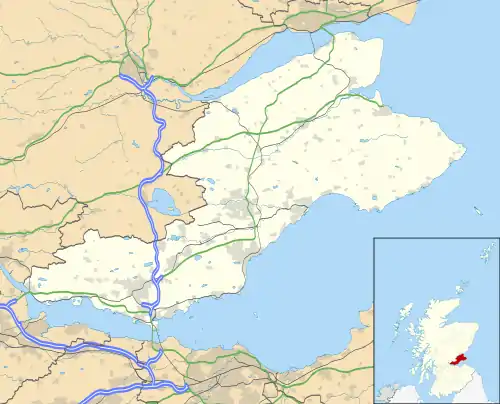| Kinghorn Town Hall | |
|---|---|
 Kinghorn Town Hall | |
| Location | St Leonard's Place, Kinghorn |
| Coordinates | 56°04′18″N 3°10′26″W / 56.0718°N 3.1739°W |
| Built | 1830 |
| Architect | Thomas Hamilton |
| Architectural style(s) | Tudor Revival style |
Listed Building – Category B | |
| Official name | St Leonard's Place And North Overgate, Town House Including Boundary Walls, Exercise Yard And Railings |
| Designated | 24 November 1972 |
| Reference no. | LB36251 |
 Shown in Fife | |
Kinghorn Town Hall is a municipal building in St Leonard's Place, Kinghorn, Fife, Scotland. The structure, which is used as holiday accommodation for tourists, is a Category B listed building.[1]
History
The first municipal building in Kinghorn was a small Saxon or Norman church, St Leonard's Chapel, which was converted into a town house and prison in the 16th century. Several Covenanters were incarcerated in the building, which was described as "horrible", during the Killing Time in the early 1680s.[2] It served as the regular meeting place of the burgh council and became known as St Leonard's Tower, but was struck by lightning in the early 19th century and was subsequently demolished.[3][4]
The current building was designed by Thomas Hamilton in the Tudor Revival style, built in ashlar stone and was completed in 1830. The design involved a symmetrical main frontage of three bays facing into St Leonard's Place. The central bay was formed by a three-stage tower which featured a square headed doorway with a hood mould in the first stage, a tri-partite mullioned and transomed window in the second stage and a corbelled clock face in the third stage. The centre bay was flanked by full-height buttresses surmounted by pinnacles. The outer bays were fenestrated by small square windows with hood moulds on the ground floor and bi-partite mullioned and transomed windows on the first floor. There was also a single-storey wing extending to the northeast. At roof level there was a parapet with corbelled turrets at the outer corners. Internally, the principal rooms were the barrel vaulted prison cells and the guardroom on the ground floor, and the courtroom on the first floor.[3] The courtroom, which also served as a council chamber, featured an ogee-headed fireplace and contained some fine decorative plasterwork.[5]
In the mid-20th century, offices for the town clerk and other council officers were established in Baliol Street.[6] The town hall continued to serve as the meeting place of the burgh council for much of the 20th century, but ceased to be the local seat of government after the enlarged Kirkcaldy District Council was formed in 1975.[7][8]
The building was acquired by the Fife Historic Buildings Trust in anticipation of a major programme of restoration works, which was managed by the trust and was completed in 2009.[9] The upper floors of the building were converted into holiday apartments for tourists,[10] while the ground floor became the head office of the Fife Historic Buildings Trust in December 2013.[11][12]
See also
References
- ↑ Historic Environment Scotland. "St Leonard's Place And North Overgate, Town House Including Boundary Walls, Exercise Yard And Railings (LB36251)". Retrieved 16 August 2022.
- ↑ The Scottish Antiquary, or, Northern Notes and Queries. Vol. 8–10. T. and A. Constable. 1894. p. 154.
- 1 2 Historic Environment Scotland. "Kinghorn, St Leonard's Place, Town Hall (52773)". Canmore. Retrieved 16 August 2022.
- ↑ Tolbooths and Town-houses Civic Architecture in Scotland to 1833. Royal Commission on the Ancient and Historical Monuments of Scotland. 1996. p. 116. ISBN 978-0114957995.
- ↑ Fenton, Alexander; Stell, Geoffrey; Shaw, John; Storrier, Susan (2000). Scottish Life and Society: Scotland's buildings. Tuckwell Press. p. 262. ISBN 978-1862321236.
Good examples of decorative plasterwork can still be found in Stirling Tolbooth (1703–1705), Falkland Town House (1800) and Kinghorn Town House (1829–1830)
- ↑ "The Electrical Journal". 1956. p. 354.
A. Deas, Burgh surveyor, Municipal Offices, Baliol Street, Kinghorn, Fifeshire.
- ↑ "Local Government (Scotland) Act 1973". Legislation.gov.uk. Retrieved 29 March 2021.
- ↑ "Kinghorn Burgh". Vision of Britain. Retrieved 16 August 2022.
- ↑ "Kinghorn Town Hall". Fife Historic Buildings Trust. Retrieved 16 August 2022.
- ↑ "Kinghorn Town Hall". Visit Scotland. Retrieved 16 August 2022.
- ↑ Stenke, Fiona (31 May 2021). "Working on Fife's Historic Buildings". Cupar Museum and Heritage Centre. Retrieved 16 August 2022.
- ↑ "Trust honours Bob Watt". The Courier and Advertiser. 11 December 2013. Retrieved 16 August 2022.